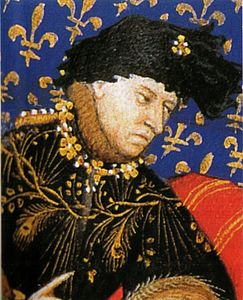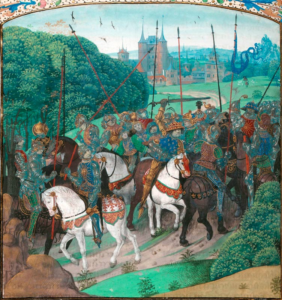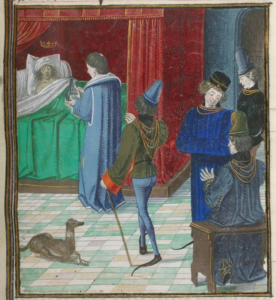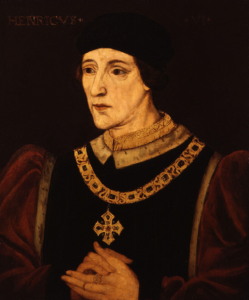CONSULTA LINK:
http://www.dossiercultura.it/accadde-oggi/il-re-folle.html
CARLO VI DI VALOIS
Carlo VI di Valois, detto il Beneamato o anche il Folle, è stato re di Francia della dinastia dei Valois dal 1380 al 1422.
 Figlio di Carlo V e di Giovanna di Borbone, ereditò il trono all’età di undici anni, nel bel mezzo della guerra dei Cent’anni. Il governo fu affidato ai suoi quattro zii: Filippo II di Borgogne, Giovanni di Berry, Luigi I d’Angiò e Luigi II di Borbone. Sebbene la maggiore età per regnare fosse a 14 anni, i duchi mantennero il potere fino a quando Carlo non se lo riprese all’età di 21 anni.
Figlio di Carlo V e di Giovanna di Borbone, ereditò il trono all’età di undici anni, nel bel mezzo della guerra dei Cent’anni. Il governo fu affidato ai suoi quattro zii: Filippo II di Borgogne, Giovanni di Berry, Luigi I d’Angiò e Luigi II di Borbone. Sebbene la maggiore età per regnare fosse a 14 anni, i duchi mantennero il potere fino a quando Carlo non se lo riprese all’età di 21 anni.
Nel 1388 Carlo VI licenziò i suoi zii e riportò al potere gli ex consiglieri di suo padre. Le condizioni politiche ed economiche del regno migliorarono in modo significativo e Carlo guadagnò fra il popolo l’epiteto di «Beneamato». Quando Carlo VI morì, la successione fu rivendicata dal figlio Carlo VII, che si trovò a fronteggiare la fase finale della Guerra dei Cent’anni.
EPISODI DI FOLLIA
Nell’estate del 1392, mentre era in corso la guerra dei 100 anni, partì a cavallo con la sua scorta per raggiungere le milizie e guidare di persona le operazioni militari contro gli Inglesi. Lo assillavano gravi preoccupazioni, egli sospettava che il tradimento si nascondesse nella sua stessa corte e minasse dall’interno la prosperità e la sicurezza del regno. Il suo Consigliere Oliver di Cisson, sfuggì di misura a un attentato mortale poco prima di partire per la guerra. Quest’episodio colpì fortemente la sensibilità del monarca che da quel momento iniziò a manifestare quello che in ambito psicologico oggi definiamo “mania di persecuzione”.
Animato da un fortissimo senso del dovere, partì ugualmente il 1° Luglio 1392, per raggiungere le truppe, ma mentre il drappello attraversava la foresta di Le Mans, uno sconosciuto scalzo e mal vestito afferrò le briglie del cavallo del re e iniziò a gridargli un terribile ammonimento: “Non cavalcare oltre. Torna indietro! Sei stato tradito”. Benché la scorta reale cercasse di allontanarlo, quest’uomo continuò a correre a fianco del re gridandoli instancabilmente, il suo monito.
Dopo aver attraversato quella fitta boscaglia, d’improvviso, ad un nobile cavaliere del seguito sfuggì di mano una lancia che andò a sbattere su di un elmo che si trovava sul terreno. Quel cozzare spezzò il silenzio di quel momento. Un rumore sordo che sorprese tutti ma, il più sorpreso di tutti fu proprio il sovrano che, all’improvviso sguainò la spada e, gridando come un ossesso iniziò a menare colpi a destra e manca, uccidendo e ferendo alcuni dei suoi uomini. Con grande fatica riuscirono a disarmarlo e immobilizzarlo; dopo di che, egli cadde in un profondo stato di stordimento e apatia.

Da quel momento, e per tutta la sua vita Carlo VI divenne “il pazzo”, intervallando incomprensibili eccessi di furore a periodi di relativa tranquillità. Durante le sue crisi arrivava a scordare ogni cosa, manifestava gravi amnesie dissociative, fuggendo dai propri famigliari e in particolare dalla moglie Isabella di Baviera. Vennero interpellati i più famosi medici e guaritori dell’epoca, ma nessuno fu in grado di stabilire una diagnosi per poterlo guarire.
Qualche tempo dopo il primo attacco del suo male, Carlo VI partecipò ad un ballo in maschera voluto da Isabella di Baviera, nonostante i medici le avessero raccomandato di far vivere il consorte in tranquillità e riposo. Carlo e altri cinque nobili, vestiti in costume da selvaggi e incatenati l’uno all’altro, stavano danzando per festeggiare il matrimonio di una damigella di corte, allorché una torcia recata da suo fratello Luigi diede fuoco all’abito di uno di essi. In pochi istanti le fiamme divamparono e bruciarono vivi gli sventurati. Solo Carlo fu salvato dal pronto intervento di sua zia, la duchessa di Berry, la quale gli gettò addosso un abito per soffocare le fiamme. Il tragico incidente delle torce umane ebbe luogo nel gennaio del 1393.
Carlo continuò di fatto a fare il re come se nessuno gli avesse realmente tolto la corona. Fare diagnosi a distanza di secoli su documentazioni spesso approssimative è difficoltoso, ma è verosimile che quella di Carlo VI fosse una schizofrenia paranoide. Egli si avvolgeva in pesanti coperte e restava immobile per ore su un letto di paglia perché fermamente convinto di essere di vetro e di potersi frantumare. Quando si muoveva lo faceva ingessato in un corsetto con costole metalliche per proteggere i suoi organi di vetro. La percezione di essere di vetro e quindi fragili è stata spesso descritta in relazioni mediche tra XI e il XVII secolo di individui di classe elevata con tratti psicotici di malinconia e depressione. Si sussurrava che Carlo VI fosse caduto vittima di un maleficio per opera di sua cognata, Valentina Visconti, moglie di suo fratello Luigi. I Visconti erano noti in tutta Europa per le pratiche di magia nera.
L’ultima pazzia di Carlo la compì poco prima di morire. Volle infatti fare testamento diseredando il figli e istituendo erede proprio il nemico dei francesi, Enrico V che sedeva sul trono d’Inghilterra. Se i suoi sudditi devoti sopportarono in silenzio le sue pazzie, proprio quella disposizione non la fecero passare. Sul trono di Francia si accomodò infatti il figlio Carlo VII che, con l’aiuto di Giovanna d’Arco, fu incoronato a Reims.

ENRICO VI DI LANCASTER
 Enrico VI, figlio di Enrico V e Caterina di Valois, divenne re quando era ancora in fasce e in seguito alla ,morte del nonno Carlo VI fu proclamato anche re di Francia.
Enrico VI, figlio di Enrico V e Caterina di Valois, divenne re quando era ancora in fasce e in seguito alla ,morte del nonno Carlo VI fu proclamato anche re di Francia.
Mentre un’ondata di miseria e di conseguenti rivolte si abbatteva sull’isola, Enrico cominciò a dare segni di pazzia e Riccardo di York assunse la guida effettiva del governo. Il sovrano sembrò qualche tempo dopo riacquistare il senno e guidato dalla forte tempra della moglie, tolse il potere a Riccardo. Iniziò così la Guerra delle due rose che durò trent’anni.
Nel 1465, mentre fuggiva in Scozia, Enrico venne catturato e imprigionato nella Torre di Londra dove morì nel 1471.
Quando aveva poco più di trent’anni ( 1453), Enrico VI fu colpito da una grave malattia mentale. Grazie allo sviluppo della psichiatria, gli esperti concordano sul fatto che il sovrano soffrisse della malattia mentale ereditata a sua volta dal nonno materno, Carlo VI di Francia, da alcuni individuata come una grave forma di schizofrenia. In base ai sintomi psicotici riportati dalle cronache, gli storici pensano che questa malattia sia stata causata dal grande stress accumulato negli anni della guerra, dall’instabilità interna e dalle difficoltà crescenti in Francia,. Come il nonno, Enrico manifestò sintomi di amnesia e disturbi dissociativi, al punto da non riuscire neanche a rendersi conto della nascita del figlio Edoardo, avvenuta durante la sua malattia.
«…Enrico divenne pazzo a 31 anni di età, perdendo la sua memoria, solo per recuperarla brevemente prima di soccombervi nuovamente, sentendo voci e avendo visioni. Potrebbe essere entrato in uno stato catatonico.»
(The American Psychiatric Publishing Textbook of Schizophrenia)
CHARLES VI OF VALOIS
Charles VI of Valois was king of France of the Valois dynasty from 1380 to 1422. Son of Charles V and Joan of Bourbon, he inherited the throne at the age of eleven, in the midst of the Hundred Years War. The government was entrusted to his four uncles: Philip II of Borgogne, John of Berry, Louis I of Anjou and Louis II of Bourbon. Although the age of majority was 14 years, the dukes retained power until Carlo recovered it at the age of 21. In 1388 Charles VI fired his uncles and brought his father’s former advisers back to power. The political and economic conditions of the kingdom improved significantly and Charles gained the epithet of “Beloved” among the people. When Charles VI died, the succession was claimed by his son Charles VII, who found himself facing the final phase of the Hundred Years War.
EPISODES OF MADNESS
In the summer of 1392, while the 100-year war was underway, he set off on horseback with his escort to join the militias and personally lead military operations against the British. Serious concerns beset him, he suspected that treachery was hiding in his own court and undermining the kingdom’s prosperity and security from within. His Counselor Oliver of Cisson narrowly escaped a fatal attack shortly before leaving for the war. This episode greatly affected the sensitivity of the monarch who from that moment began to manifest what in the psychological field we now call “persecution mania”.
Animated by a strong sense of duty, he also left on 1 July 1392, to reach the troops, but while the squad crossed the forest of Le Mans, a barefoot and poorly dressed unknown grabbed the bridle of the king’s horse and started shouting at him. terrible admonition: “Don’t ride any further. Come back! You have been betrayed. ” Although the royal escort tried to drive him away, this man continued to run alongside the king, tirelessly shouting his warning at him. After passing through that dense forest, suddenly a noble knight from the retinue got out of hand a spear that crashed into a helmet that was on the ground. That clash broke the silence of that moment. A dull noise that surprised everyone but, the most surprised of all was the sovereign who, suddenly, drew his sword and, shouting like an obsessed man, began to strike right and left, striking, killing and injuring some of his men. With great effort they managed to disarm and immobilize him; after which, he fell into a deep state of dizziness and apathy.
From that moment, and throughout his life, Charles VI became “the madman”, interspersing incomprehensible excesses of fury with periods of relative tranquility. During his crises he came to forget everything, manifested serious dissociative amnesia, fleeing from his family and in particular from his wife Isabella of Bavaria. The most famous doctors and healers of the time were consulted, but no one was able to establish a diagnosis in order to be able to heal him.
Some time after the first attack of her illness, Charles VI participated in a masked ball wanted by Isabella of Bavaria, although the doctors had recommended that her husband live in tranquility and rest. Charles and five other nobles, dressed in savage costumes and chained to each other, were dancing to celebrate the wedding of a court bridesmaid, when a torch brought by his brother Luigi set fire to the dress of one of them. In a few moments the flames blazed and burned the unfortunate alive. Only Charles was saved by the prompt intervention of his aunt, the Duchess of Berry, who threw a suit on him to suffocate the flames. The tragic accident of human torches took place in January 1393.
Charles actually continued to make the king as if no one had really taken off his crown. Diagnosing centuries of often approximate documentation is difficult, but it is likely that that of Charles VI was a paranoid schizophrenia. He wrapped himself in heavy blankets and remained motionless for hours on a straw bed because he was firmly convinced that he was made of glass and could shatter. When he moved he made him cast in a corset with metal ribs to protect his glass organs.
The perception of being glass and therefore fragile has often been described in medical relationships between the 11th and 17th centuries of high-class individuals with psychotic traits of melancholy and depression. It was whispered that Charles VI had fallen victim to a curse by his sister-in-law, Valentina Visconti, wife of his brother Luigi. The Visconti were known throughout Europe for black magic practices.
Carlo’s latest madness was accomplished just before he died. In fact, he wanted to make a testament by disinheriting his children and establishing the French enemy, Henry V, who sat on the throne of England. If his devoted subjects silently endured his madnesses, that very arrangement did not make it go away. In fact, his son Charles VII sat on the throne of France and was crowned in Reims with the help of Joan of Arc.
HENRY VI OF LANCASTER
Henry VI, son of Henry V and Catherine of Valois, became king of England when he was still in swaddling clothes and following the death of his grandfather Charles VI he was also proclaimed king of France. As a wave of misery and subsequent riots broke out on the island, Henry began to show signs of madness and Richard of York assumed effective leadership of the government. The ruler seemed some time after regaining his senses and led by the strong temper of his wife, took power from Richard. Thus began the War of the two roses which lasted thirty years. In 1465, while fleeing to Scotland, Henry was captured and imprisoned in the Tower of London where he died in 1471
When he was just over thirty (1453), Henry VI was struck by a serious mental illness. Thanks to the development of psychiatry, experts agree that the sovereign suffered from mental illness inherited in turn from his maternal grandfather, Charles VI of France, whom some identified as a serious form of schizophrenia. According to the psychotic symptoms described in the chronicles, by the historians observed by this disease it was caused by the great stress accumulated during the war years, by internal instability and growing difficulties in France,. Like his grandfather, Henry displays symptoms of amnesia and dissociative disorders, to the point of not even being able to realize the birth of his son Edward, which happened during his illness.
«…Henry, went made at the age 31 and lost his memory, only to recover briefly before succumbing again, hearing voices and seeing visions. He may have lapsed into a catatonic-like stupor»
(The American Psychiatric Publishing Textbook of Schizophrenia)
SITOGRAFIA
https://it.wikipedia.org/wiki/Carlo_VI_di_Francia
https://ilformat.info/2019/11/18/carlo-vi-il-re-di-francia-che-pensava-di-esser-fatto-di-vetro/
https://it.wikipedia.org/wiki/Enrico_VI_d%27Inghilterra
BIBLIOGRAFIA
Encicolpedia europea pagina 914 volume II, Aldo Garzanti editore 1976
ARTICOLO DI GIORGIA STOMBOLI DELLA CLASSE III B DEL LICEO CLASSICO

Commenti recenti